|
|
|
Sort Order |
|
|
|
Items / Page
|
|
|
|
|
|
|
| Srl | Item |
| 1 |
ID:
096614


|
|
|
|
|
| Publication |
2010.
|
| Summary/Abstract |
This contribution analyses the European electricity markets with respect to their aptitude to absorb large amounts of wind energy. Thereby in a first step the market designs of the major European power markets in France, Germany, Scandinavia, Spain and UK are reviewed, with a particular focus on liquidity in the spot and intraday markets. Then some key features of the short-term adjustments required by wind energy are discussed and the necessity of sufficient liquidity in intraday markets is highlighted. For the example of the German market subsequently the discrepancy between the physical short-term adjustment needs and the traded volumes on the intraday market is analyzed. This leads to an evaluation of proposals for improving the liquidity on the short-term market, including the use of continuous spot trading like in UK or the use of intraday auctions like in Spain.
|
|
|
|
|
|
|
|
|
|
|
|
|
|
|
|
| 2 |
ID:
097457


|
|
|
|
|
| Publication |
2010.
|
| Summary/Abstract |
This contribution analyses the European electricity markets with respect to their aptitude to absorb large amounts of wind energy. Thereby in a first step the market designs of the major European power markets in France, Germany, Scandinavia, Spain and UK are reviewed, with a particular focus on liquidity in the spot and intraday markets. Then some key features of the short-term adjustments required by wind energy are discussed and the necessity of sufficient liquidity in intraday markets is highlighted. For the example of the German market subsequently the discrepancy between the physical short-term adjustment needs and the traded volumes on the intraday market is analyzed. This leads to an evaluation of proposals for improving the liquidity on the short-term market, including the use of continuous spot trading like in UK or the use of intraday auctions like in Spain.
|
|
|
|
|
|
|
|
|
|
|
|
|
|
|
|
| 3 |
ID:
171376


|
|
|
|
|
| Summary/Abstract |
Policy makers across Europe have implemented renewable support policies with several policy objectives in mind. Among these are achieving ambitious renewable energy targets at the lowest cost, reducing CO2-emissions and promoting technology improvement through learning-by-doing. Using a detailed country-level model of generation markets, we address the question of how policies that subsidize renewable energy (feed-in premia and renewable portfolio standards (RPSs)) versus capacity (investment subsidies) impact the mix of renewable investments, electricity costs, renewable share, the amount of subsidies, and consumer prices in the EU electric power market in 2030 and how they interact with other policies such as the EU ETS. Our analysis shows that subsidies of energy output are cost-effective for achieving renewable energy targets in the short run, whereas policies tied to capacity installation yield more investment and might be more effective in reducing technology costs in the longer term. The difference in costs between these two policy options diminish with higher CO2-prices. Although the differences are significant, they are smaller than cost impacts of other renewable policy design features, namely the effect of not allowing EU members to meet their individual targets by trading renewable credits with other member states.
|
|
|
|
|
|
|
|
|
|
|
|
|
|
|
|
| 4 |
ID:
099331


|
|
|
|
|
| Publication |
2010.
|
| Summary/Abstract |
Throughout the history of the electricity industry, regulatory reform has been driven by the pursuit of tools able to create conditions that would favour infrastructure investment and, generally, to surmount the obstacles that hinder system expansion. This article addresses the interaction between regulatory schemes and electric power generation investment, with a review of the changing role of the State in the expansion of electricity supply in Latin America. It contains a critical assessment of changes in the regulatory framework since the outset of electric power market reform, describing the successive approaches to regulation adopted in the last three decades. The aim of this analysis is to help identify the key factors underlying the evolution of energy policies and to contribute to the formulation of a prospective view of the direction this evolution may reasonably be expected to take.
|
|
|
|
|
|
|
|
|
|
|
|
|
|
|
|
| 5 |
ID:
105742


|
|
|
|
|
| Publication |
2011.
|
| Summary/Abstract |
In this paper, characteristics of the prices of reserves and regulation services in the Ontario, New York and ERCOT electricity markets are studied. More specifically, price variability, price jumps, long-range correlation, and non-linearity of the prices are analyzed using the available measures in the literature. For the Ontario electricity market, the prices of 10-min spinning, 10-min non-spinning, and 30-min operating reserves for the period May 1, 2002 to December 31, 2007 are analyzed. For the New York market, prices of the same reserves plus regulation service are studied for the period February 5, 2005 to December 31, 2008. For the ERCOT market, we analyze the prices of responsive reserve, regulation up and regulation down services, for the period January 1, 2005 to December 31, 2009. The studied characteristics of operating reserve and regulation prices are also compared with those of energy prices. The findings of this paper show that the studied reserve and regulation prices feature extreme volatility, more frequent jumps and spikes, different peak price occurrence time, and lower predictability, compared to the energy prices.
|
|
|
|
|
|
|
|
|
|
|
|
|
|
|
|
| 6 |
ID:
166719


|
|
|
|
|
| Summary/Abstract |
Across the world, the electricity industry is changing with the advent of renewable energy sources such as solar and wind power. As these are exposed to intermittency, seasonality, and global-climate-variation, policy-makers' concerns are now shifting towards security of supply. In fact, the industry confronts three conflicting goals: security of supply, competitive prices to customers, and environmental protection. In this context, and given the multiple uncertainties of technology transformation, this paper uses modelling-based scenario analysis to investigate different extreme and plausible futures. Simulation is used to analyse policies aimed at increasing the penetration of renewables and to explore how these energy sources may affect system reliability. This paper explores the effect of incorporating renewables in Colombia, where a large hydroelectric component has led to insufficient electricity being available during droughts and to high electricity price volatility. Though not intuitive at first glance, this paper shows that renewables may contribute to: i) increased security of supply through complementarity, e.g., it does not rain when the sun shines; ii) reduced price volatility in the medium-term, and iii) increased industry sustainability.
|
|
|
|
|
|
|
|
|
|
|
|
|
|
|
|
| 7 |
ID:
174955
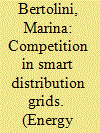

|
|
|
|
|
| Summary/Abstract |
Smart grids are often considered a cornerstone of energy transition and market liberalization in electric industries. From a critical reading of the interdisciplinary academic and governmental literature, we draw a new definition of grid smartness that is based on the reduction of the volatility of market prices and flows. Then, relying on a simple industrial-organization model of the electric market, we analyze the impact of smart grids on competition among energy suppliers and on the incentives of distribution system operators to invest in it. We show that the risk-reduction effect of smart grids pushes firms to supply more energy. However, the latter can be compensated by an indirect competition effect of investments in smart grids which prevents the entry of firms into the market, though the aggregate effect on energy supply is always positive. We also find that distribution system operators under-invest in smart grids because they fail to internalize positive externalities on energy consumers and producers.
|
|
|
|
|
|
|
|
|
|
|
|
|
|
|
|
| 8 |
ID:
112325


|
|
|
|
|
| Publication |
2012.
|
| Summary/Abstract |
Internal European electricity markets are a target set by the European Union (EU) and under development at present. This article presents the findings of a Delphi study focusing on the prospects of European electricity markets. The main aim is to report the obstacles that participants in the survey felt were the most critical ones affecting competition in the European electricity markets of the future. The respondents were European electricity market specialists, and the themes of the survey ranged from transmission networks and electricity trade to demand flexibility. One of the key findings was shared concern over the adequacy of transmission network capacity in Europe. It was considered that technical issues, such as existing transmission network bottlenecks, are most likely to form obstacles to creating common European electricity markets if new capacity is not built quickly enough. It was seen by the panellists that electricity trading arrangements, whilst important, are unlikely to form a barrier to the development of an internal electricity market. It was noted that electricity trading issues have recently been the subject of development work in the EU.
|
|
|
|
|
|
|
|
|
|
|
|
|
|
|
|
| 9 |
ID:
104905


|
|
|
|
|
| Publication |
2011.
|
| Summary/Abstract |
In this article, we discuss the "cycle hypothesis" in electricity generation, which states that the introduction of deregulation in an electricity system might lead to sustained fluctuations of over- and under-capacity. The occurrence of cycles is one of the major threats for electricity markets as it affects the security of supply, and creates uncertainty in both the profitability of electricity companies and in consumer prices. We discuss the background for these cycles using analogies with other capital-intensive industries, along with evidence from the analysis of behavioral simulation models as well as from experimental electricity markets. Using data from the oldest deregulated markets we find support for the hypothesis in the case of the English and Chilean markets, based on an autocorrelation analysis. Evidence from the Nordpool market is more ambiguous, although we might be observing the first half of a cycle in generation capacity. Comparing a simulation of the English market performed in 1992 with the actual performance we can observe that the qualitative behavior of the model is consistent with the actual evolution. Finally, we discuss possible mechanisms for damping cycles in electricity generation, such as mothballing, capacity payments, and reliability markets.
|
|
|
|
|
|
|
|
|
|
|
|
|
|
|
|
| 10 |
ID:
126838


|
|
|
|
|
| Publication |
2014.
|
| Summary/Abstract |
This paper examines the implications of alternative forms of cap-and-trade regulations on the California electricity market. Specific focus is given to the implementation of a downstream form of regulation known as the first-deliverer policy. Under this policy, importers (i.e., first-deliverers) of electricity into California are responsible for the emissions associated with the power plants from which the power originated, even if those plants are physically located outside of California. We find that, absent strict non-economic barriers to changing import patterns, such policies are extremely vulnerable to reshuffling of import resources. The net impact implies that the first-deliverer policies will be only marginally more effective than a conventional source-based regulation.
|
|
|
|
|
|
|
|
|
|
|
|
|
|
|
|
| 11 |
ID:
177111


|
|
|
|
|
| Summary/Abstract |
Competitive electricity markets can procure reserve generation through a market in which the demand for reserves is administratively established. A downward sloping or stepped administrative demand curve is commonly termed an operating reserve demand curve (ORDC). We propose a dynamic formulation of an ORDC with generator forced outage probabilities conditional on ambient temperature to implement scarcity pricing in a wholesale electricity market. This formulation improves on common existing methods used by wholesale market operators to articulate ORDCs by explicitly accounting for a large source of observed variability in generator forced outages, whereby for a fixed load, more reserves are required during times of extreme heat and cold to maintain a constant risk of reserve shortage. Such a dynamic ORDC increases social welfare by $17.1 million compared to current practice in the PJM Interconnection during a high load week in a welfare-maximizing electricity market with co-optimized procurement of energy and reserves. A dynamic ORDC increases reserve prices under scarcity conditions, but has minimal effects on total market payments. The results are directly relevant to the modeled two-settlement electricity market in PJM, which is currently undergoing enhancements to its ORDC.
|
|
|
|
|
|
|
|
|
|
|
|
|
|
|
|
| 12 |
ID:
179729
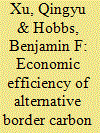

|
|
|
|
|
| Summary/Abstract |
To be effective, policies addressing power sector carbon emissions in jurisdictions that are embedded in larger carbon markets must account for carbon embodied in imports and the potential for leakage. Yet analyses of alternative border carbon adjustment (BCA) policies that carefully model the impact of generation mix, net load distributions, and transmission limits are rare in the literature. With a generation-transmission expansion planning model of Western North America, we compare the impacts of alternative BCA schemes that California's carbon pricing system could implement. These include no BCA, facility (import source)-based deemed emission rate, a facility-neutral and constant (over-time) rate, and a facility-neutral and dynamic rate. Our results suggest that, when compared to no BCA or BCA using facility-based deemed rates, a facility-neutral BCA can improve efficiency by simultaneously lowering market-wide emissions and costs without raising California consumer expenditures. Emissions leakage also declines significantly. The precise value of the deemed rate affects these gains; setting it equal to marginal emission rates external to California is most efficient. We also show that California's carbon pricing encourages more interstate transmission expansion because power imports become more profitable. However, BCAs that cost-effectively lower total regional emissions will dampen those incentives.
|
|
|
|
|
|
|
|
|
|
|
|
|
|
|
|
| 13 |
ID:
116941


|
|
|
|
|
| Publication |
2012.
|
| Summary/Abstract |
We present here economic findings from a major study by Australia's Commonwealth Scientific and Industrial Research Organisation (CSIRO) on the value of distributed energy technologies (DE; collectively demand management, energy efficiency and distributed generation) for reducing greenhouse gas emissions from Australia's energy sector (CSIRO, 2009). The study covered potential economic, environmental, technical, social, policy and regulatory impacts that could result from their wide scale adoption. Partial Equilibrium modeling of the stationary energy and transport sectors found that Australia could achieve a present value welfare gain of around $130 billion when operating under a 450 ppm carbon reduction trajectory through to 2050. Modeling also suggests that reduced volatility in the spot market could decrease average prices by up to 12% in 2030 and 65% in 2050 by using local resources to better cater for an evolving supply-demand imbalance. Further modeling suggests that even a small amount of distributed generation located within a distribution network has the potential to significantly alter electricity prices by changing the merit order of dispatch in an electricity spot market. Changes to the dispatch relative to a base case can have both positive and negative effects on network losses.
|
|
|
|
|
|
|
|
|
|
|
|
|
|
|
|
| 14 |
ID:
093478


|
|
|
|
|
| Publication |
2010.
|
| Summary/Abstract |
We look at the effect of modeling branch-outage contingencies on locational marginal prices. To model contingencies in the day-ahead auction, we formulate a two-stage stochastic program. Rather than follow the current practice of including a list of possible contingencies that must be satisfied, we incorporate a larger set of contingencies in the model and allow contingencies to result in load reductions/outages at a cost. The model can be used and interpreted in two ways. One is to look at the tradeoff between reliability and outage costs. Another is to consider the load losses resulting from a contingency to be consumer offers of load reductions in response to line outages as part of the day-ahead auction. In analyzing the model structure, we find that the prices in the model closer in definition to those currently used in the day-ahead auction do not maximize expected surplus because the day-ahead auction produces prices that assume shortages will never occur. This raises issues with the design of auctions with important stochastic elements in the market. We present results for a 68-node grid with 86 branches (lines and transformers) to illustrate how prices and expected values change as the costs of outages are varied.
|
|
|
|
|
|
|
|
|
|
|
|
|
|
|
|
| 15 |
ID:
150804
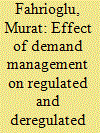

|
|
|
|
|
| Summary/Abstract |
Our society derives a quantifiable benefit from electric power. In particular, forced outages or blackouts have enormous consequences on society, one of which is loss of economic surplus. The society relies on having a continuous supply of electrical energy. Some customers may willingly risk this continuous supply and participate in demand management programs for electrical power. If the power system grid is in trouble, electric utilities need to have demand relief. Customers willing to reduce their demand to help the system can receive an incentive fee for helping the utilities. Demand relief can be system wide or location specific. Sometimes it can be more effective to fix the electrical demand vs. supply imbalance from the demand side. The value of demand management contracts is greatly affected by customer location. Inclusion of locational attributes into the contract design procedure increases the effectiveness of the contracts by helping a utility get more value from its demand management programs. Independent System Operators and regulators, among others, can also benefit from effective demand management. This paper will investigate how this type of demand management contracts can help the electricity sector both in regulated and deregulated environments.
|
|
|
|
|
|
|
|
|
|
|
|
|
|
|
|
| 16 |
ID:
192385
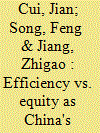

|
|
|
|
|
| Summary/Abstract |
Emissions reduction in the electricity sector is critical in achieving China's carbon neutrality target. While a national carbon trading market that covers the electricity sector has been established, its effectiveness depends on how this sector evolves into being a more integrated market. This study evaluated the impact of China's electricity market integration on the cost-effectiveness of carbon pricing. An integrated (regional electricity market) and a segmented (provincial electricity market) market scenario were used to identify possible reform paths going forward. Using high-frequency datasets of the five southern provinces in 2018, we assessed the impact of electricity market integration on the abatement potential and cost-effectiveness of carbon pricing. We found that carbon prices need to be as high as 200 yuan/ton to begin achieving overall carbon reduction. In this context, the regional market is more cost-effective in reducing emissions than the provincial one, as the abatement costs are saved by around 60% compared to the latter under the same emission reduction targets. However, the regional market may also raise potential equity issues. The provincial-level distribution of carbon emission reductions, as well as the withdrawal of coal power, are more concentrated in the regional market than in the provincial one, which indicates an inequitable social-economic-environmental impacts of market integration. Our research findings would help to improve policymakers' understanding of the interaction between carbon pricing and electricity market reforms. This would then assist them in coordinating an effective design of both the carbon and electricity markets, in addition to supporting China's carbon neutrality target.
|
|
|
|
|
|
|
|
|
|
|
|
|
|
|
|
| 17 |
ID:
099233
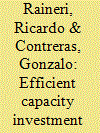

|
|
|
|
|
| Publication |
2010.
|
| Summary/Abstract |
We develop a model for a power market with the characteristics of the Chilean power supply industry, which is an integrated system with a system operator (SO) with a vast authority to define the dispatch of the system. We evaluate whether a large joint power generator project made up by the two largest power generators is an anti-competitive project. Considering four investment technologies for power generation, namely, hydro, coal, diesel, and an advantageous hydro technology which can only be built in a large scale (HidroAysén) for the joint venture case, we use an oligopolistic Cournot model and a Benevolent Social Planner, both calibrated to the Chilean power industry, in order to assess the efficiency of alternative investment strategies and conditions whether the HidroAysén joint venture project can be barred to be judged as anti-competitive. Results suggest that the joint venture is an efficient investment and there is a pro-competitive behaviour on the part of the two power generators, and that there are benefit to consumers, who should expect non-increasing energy prices as a result of the advantageous hydrotechnology.
|
|
|
|
|
|
|
|
|
|
|
|
|
|
|
|
| 18 |
ID:
097459
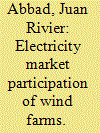

|
|
|
|
|
| Publication |
2010.
|
| Summary/Abstract |
In the last 10 years, more than 15 GW of wind power (Asociación Empresarial Eólica (Spanish Wind Energy Association), Nota de prensa (Press release) 17 de enero de 2008. http://www.aeeolica.org/doc/NP_080117_Espana_supera_los_15000_MW_eolicos.pdf) have been installed in Spain, of which more than 3.5 GW in 2007. Furthermore, plans are to reach 20 GW by 2010 and there are expectations of an installed capacity exceeding 40 GW by 2020. This article will present the innovative solutions for technical and economical integration that allow to reach such high level wind penetration objectives (the system peaks at around 44 GW and is almost isolated). It will be described how the regulation has evolved from a pure Feed-in-Tariff to a market+premium option, where technical and economic integration has been a priority. Today, approximately 97% of installed wind capacity accesses the Spanish wholesale electricity market. Market integration has been crucial, sending the correct signals to participants to look for the optimum technical solutions. Technical improvements have come from both wind power producers (fault-ride-through capabilities, visibility and controllability of wind power, power production forecasting, reactive power control) and the system operator (specific control centre dedicated to Renewable Energy Sources (RES), new security analysis tools, gaining technical confidence of wind capabilities).
|
|
|
|
|
|
|
|
|
|
|
|
|
|
|
|
| 19 |
ID:
096616
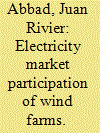

|
|
|
|
|
| Publication |
2010.
|
| Summary/Abstract |
In the last 10 years, more than 15 GW of wind power (Asociación Empresarial Eólica (Spanish Wind Energy Association), Nota de prensa (Press release) 17 de enero de 2008. http://www.aeeolica.org/doc/NP_080117_Espana_supera_los_15000_MW_eolicos.pdf) have been installed in Spain, of which more than 3.5 GW in 2007. Furthermore, plans are to reach 20 GW by 2010 and there are expectations of an installed capacity exceeding 40 GW by 2020. This article will present the innovative solutions for technical and economical integration that allow to reach such high level wind penetration objectives (the system peaks at around 44 GW and is almost isolated). It will be described how the regulation has evolved from a pure Feed-in-Tariff to a market+premium option, where technical and economic integration has been a priority. Today, approximately 97% of installed wind capacity accesses the Spanish wholesale electricity market. Market integration has been crucial, sending the correct signals to participants to look for the optimum technical solutions. Technical improvements have come from both wind power producers (fault-ride-through capabilities, visibility and controllability of wind power, power production forecasting, reactive power control) and the system operator (specific control centre dedicated to Renewable Energy Sources (RES), new security analysis tools, gaining technical confidence of wind capabilities).
|
|
|
|
|
|
|
|
|
|
|
|
|
|
|
|
| 20 |
ID:
069813


|
|
|
|
|
|
|
|